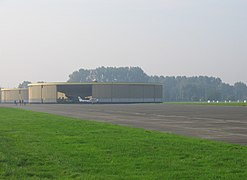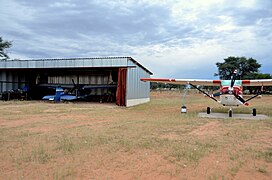
An airship or dirigible balloon is a type of aerostat or lighter-than-air aircraft that can navigate through the air under its own power. Aerostats gain their lift from a lifting gas that is less dense than the surrounding air.
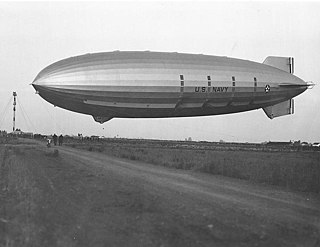
USS Akron (ZRS-4) was a helium-filled rigid airship of the U.S. Navy, the lead ship of her class, which operated between September 1931 and April 1933. It was the world's first purpose-built flying aircraft carrier, carrying F9C Sparrowhawk fighter planes, which could be launched and recovered while it was in flight. With an overall length of 785 ft (239 m), Akron and her sister ship Macon were among the largest flying objects ever built. Although LZ 129 Hindenburg and LZ 130 Graf Zeppelin II were some 18 ft (5.5 m) longer and slightly more voluminous, the two German airships were filled with hydrogen, and so the two US Navy craft still hold the world record for the largest helium-filled airships.

Moffett Federal Airfield, also known as Moffett Field, is a joint civil-military airport located in an unincorporated part of Santa Clara County, California, United States, between northern Mountain View and northern Sunnyvale. On November 10, 2014, NASA announced that it would be leasing 1,000 acres (400 ha) of the airfield property to Google for 60 years.

USS Shenandoah was the first of four United States Navy rigid airships. It was constructed during 1922–1923 at Lakehurst Naval Air Station, and first flew in September 1923. It developed the U.S. Navy's experience with rigid airships and made the first crossing of North America by airship. On the 57th flight, Shenandoah was destroyed in a squall line over Ohio in September 1925.

USS Los Angeles was a rigid airship, designated ZR-3, which was built in 1923–1924 by the Zeppelin company in Friedrichshafen, Germany, as war reparations. It was delivered to the United States Navy in October 1924 and after being used mainly for experimental work, particularly in the development of the American parasite fighter program, was decommissioned in 1932.

USS Macon (ZRS-5) was a rigid airship built and operated by the United States Navy for scouting and served as a "flying aircraft carrier", carrying up to five single-seat Curtiss F9C Sparrowhawk parasite biplanes for scouting or two-seat Fleet N2Y-1s for training. In service for less than two years, the Macon was damaged in a storm and lost off California's Big Sur coast in February 1935, though most of the crew were saved. The wreckage is listed as the USS Macon Airship Remains on the U.S. National Register of Historic Places.

Tillamook Air Museum is an aviation museum south of Tillamook, Oregon in the United States. The museum is located at a former U.S. Navy Air Station and housed in a former blimp hangar, known as "Hangar B", which is the largest clear-span wooden structure in the world.

Lakehurst Maxfield Field, formerly known as Naval Air Engineering Station Lakehurst, is the naval component of Joint Base McGuire–Dix–Lakehurst, a United States Air Force-managed joint base headquartered approximately 25 mi (40 km) east-southeast of Trenton in Manchester Township and Jackson Township in Ocean County, New Jersey, United States. It is primarily the home to Naval Air Warfare Center Aircraft Division Lakehurst, although the airfield supports several other flying and non-flying units as well. Its name is an amalgamation of its location and the last name of Commander Louis H. Maxfield, who lost his life when the R-38/USN ZR-2 airship crashed during flight on 24 August 1921 near Hull, England.
An airborne aircraft carrier is a type of mother ship aircraft which can carry, launch, retrieve and support other smaller parasite aircraft.
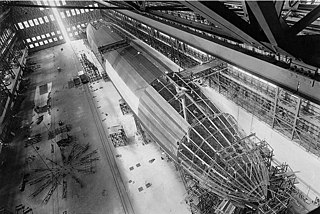
A rigid airship is a type of airship in which the envelope is supported by an internal framework rather than by being kept in shape by the pressure of the lifting gas within the envelope, as in blimps and semi-rigid airships. Rigid airships are often commonly called Zeppelins, though this technically refers only to airships built by the Luftschiffbau Zeppelin company.
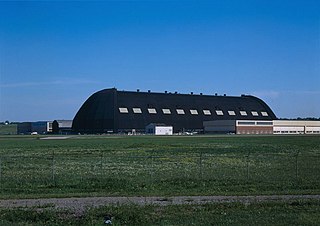
The Goodyear Airdock is a construction and storage airship hangar in Akron, Ohio. At its completion in 1929, it was the largest building in the world without interior supports.

Hangar No. 1 is an airship hangar located at Naval Air Engineering Station Lakehurst in Manchester Township, in Ocean County, New Jersey, United States. It was the intended destination of the rigid airship LZ 129 Hindenburg prior to the Hindenburg disaster on May 6, 1937, when it burned while landing. Built in 1921, it is one of the oldest surviving structures associated with that period's development of lighter-than-air flight. It was designated a National Historic Landmark in 1968.

Hangar One is one of the world's largest freestanding structures, covering 8 acres at Moffett Field near Mountain View, California in the San Francisco Bay Area.
Airship hangars are large specialized buildings that are used for sheltering airships during construction, maintenance and storage. Rigid airships always needed to be based in airship hangars because weathering was a serious risk.
The Weeksville Dirigible Hangar is an airship manufacturing, storage and test facility originally built by the United States Navy in 1941 for servicing airships conducting anti-submarine patrols of the US coast and harbors. It is located on the former Naval Air Station Weeksville in Elizabeth City, North Carolina, approximately 2 miles southeast of the present day Coast Guard Air Station Elizabeth City.
The U.S. Naval Air Station, Sunnyvale Historic District, also known as Shenandoah Plaza, is a historic district located on 62.48 acres (25.3 ha) at Moffett Field, California.
In the nation's quest to provide security along its lengthy coastlines, air reconnaissance was put forth by the futuristic Rear Admiral William A. Moffett. Through his efforts, two Naval Air Stations were commissioned in the early 1930s to port the Naval Airships (dirigibles) which he believed capable of meeting this challenge.
The United States Navy proposed to the U.S. Congress the development of a lighter-than-air station program for anti-submarine patrolling of the coast and harbors. This program proposed, in addition to the expansion at Naval Air Station and Lakehurst, the construction of new stations. The original contract was for steel hangars, 960 ft (290 m) long, 328 ft (100 m) wide and 190 ft (58 m) high, helium storage and service, barracks for 228 men, a power plant, landing mat, and a mobile mooring mast.
There are three historic airship hangars at Moffett Field, in Mountain View in the southern San Francisco Bay Area, California. Hangar One is based on a structure of steel girders, while Hangars Two and Three are of wood. They are among the world's largest freestanding structures.

The Akron-class airships were a class of two rigid airships constructed for the US Navy in the early 1930s. Designed as scouting and reconnaissance platforms, the intention for their use was to act as "eyes for the fleet", extending the range at which the US Navy's Scouting Force could operate to beyond the horizon. This capability was extended further through the use of the airships as airborne aircraft carriers, with each capable of carrying a small squadron of airplanes that could be used both to increase the airship's scouting range, and to provide self-defense for the airship against other airborne threats.















